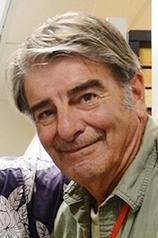
Usually the life cycle--from egg to caterpillar to chrysalis to adult—takes about a month, but this one took only 24.5 days.
“She was in a hurry,” said Kareofelas, an associate at the Bohart Museum of Entomology, University of California, Davis, and a retired finance director of the UC Davis School of Medicine.
The egg hatched in 3.5 days. The caterpillar formed a chrysalis 12.5 days later. The monarch emerged or eclosed 8.5 days later. And it took only two hours—usually it's around four—for her to dry her wings and fly away.
“You're Ruth,” Kareofelas told her as she dried her wings on Sept. 19. “You're alive. You're going to fly.”
Kareofelas decided to name her Ruth that morning, 24 hours after the death of Supreme Court Justice Ruth Bader Ginsburg, a champion of gender equality and women's rights.

“I just happened to see her laying an egg on my milkweed,” he said.
Kareofelas documented the life stages on his Facebook page, daily educating his readers about the iconic butterfly, and posting photos that he captured with his “point-and-shoot camera,” a pocket-sized Canon SB890IS.
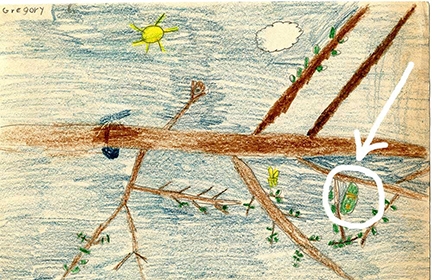
Kareofelas photographed her limp wings slowly expanding and “hardening.”
“In the wild, the butterfly is very vulnerable at this stage,” he said. “It cannot fly.”
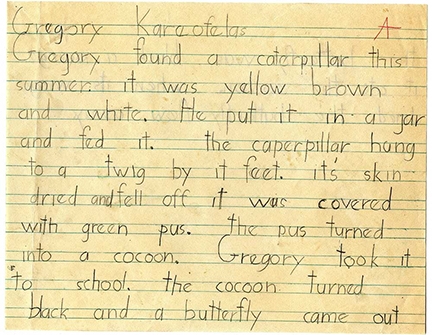
Like her namesake, Ruth the Monarch showed independence, determination and drive.
“So, at 10 this morning (Sept. 19), I took her outside and released her,” Kareofelas wrote on Facebook. “She immediately flew to the top of the plum tree and from there, off she went. Goodbye, Ruth, stay strong and come back next spring.”
He's hoping she'll make it to the overwintering grounds along coastal California and return in February.
Childhood Interest
Kareofelas first became interested in butterflies in 1951, when as a second-grader at the Holy Rosary Academy, Woodland, he wrote and illustrated a butterfly booklet.
“Luckily, I had the kind of mother that saved this booklet,” Greg said, noting that was almost 70 years ago. “We did not know the name monarch, but you can see that I described a monarch caterpillar, chrysalis and adult butterfly. The drawing shows a green chrysalis, even showing a golden band.”
“There was no one guiding me--neither Mom nor Dad was versed in anything nature, but they were very supportive,” Greg recalled. He read the children's book, “Golden Guide to Insects,” and later borrowed a copy of John Henry Comstock's “How to Know the Butterflies” from the Yolo County Library. “The irony is most of what was in those two books was more for the East Coast, rather than California.”
Kareofelas went on to study business administration at Sacramento State College, serve in the U.S. Army (Korea USS Pueblo Crisis 1968-69) and then accepted a position at the UC Davis School of Medicine. “So, nothing butterfly related there.”
Kareofelas renewed his interest in butterflies in the 1970s when he visited the Bohart Museum of Entomology, named for Professor Richard Bohart and “run by Bob Schuster.” Then located in Briggs Hall, Kleiber Hall Drive, the Bohart Museum is now housed in the Academic Surge Building on Crocker Lane. UC Davis entomology professor Lynn Kimsey, a former graduate student of Bohart's, directs the museum, which includes a global collection of nearly 8 million insect specimens, plus a live “petting zoo”(Madagascar hissing cockroaches, walking sticks and tarantulas) and a gift shop.
Kareofelas, a member of the Lepidopterists Society, is always eager to learn and share insect information. He confers with butterfly guru Art Shapiro, UC Davis distinguished professor of evolution and ecology (who hasn't seen a monarch egg or caterpillar all year), and serves as a volunteer at the Bohart Museum, where at special events, he shows butterfly and moth specimens with Lepidoptera curator Jeff Smith.
The Davis resident has led educational trips for Sutter Buttes Foundation, California Native Plant Society, Jepson Prairie Preserve, and the Placer Land Trust. He and UC Davis-trained entomologist Fran Keller, now a professor at Folsom Lake College, teamed to spotlight the California dogface butterfly on posters and in a book, “The Story of the Dogface Butterfly.” Kareofelas continues to lead tours of the Placer Land Trust's dogface butterfly habitat near Auburn.
“I am lucky to have been able to get to know some incredible folks—the Bohart crew and Shapiro—and through the Lepidopterists Society,” Kareofelas said.
Ruth the Monarch is lucky, too. She could have been a meal for a spider, a lady beetle or a milkweed bug, or parasitized by a tachinid fly or wasp.
Didn't happen.
“You're Ruth. You're alive. You're going to fly.”
Attached Images:
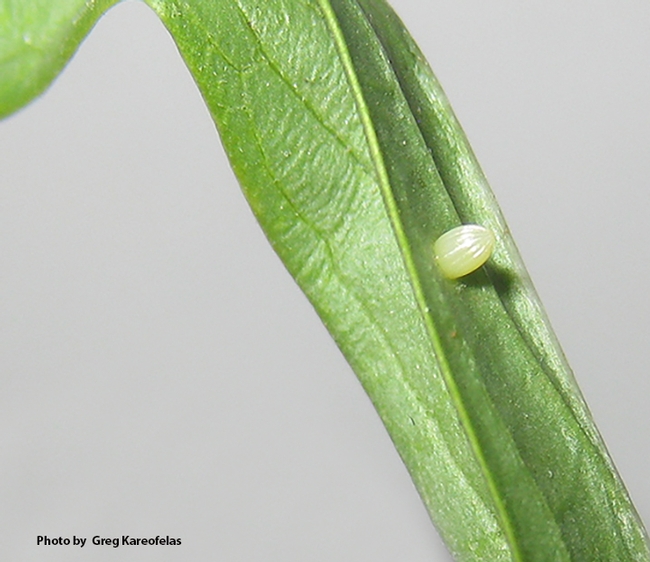
The Egg: Greg Kareofelas collected this egg from a narrowleaf milkweed in his Davis yard on Aug. 25. (Photo by Greg Kareofelas)
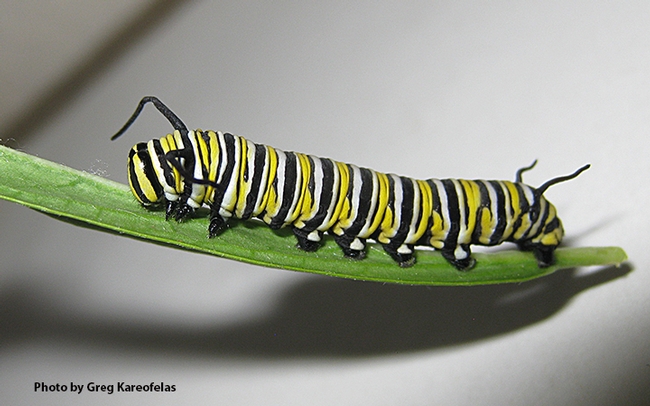
The Caterpillar: The egg that Greg Kareofelas collected Aug. 25 became a larva or caterpillar 3.5 days later. (Photo by Greg Kareofelas)
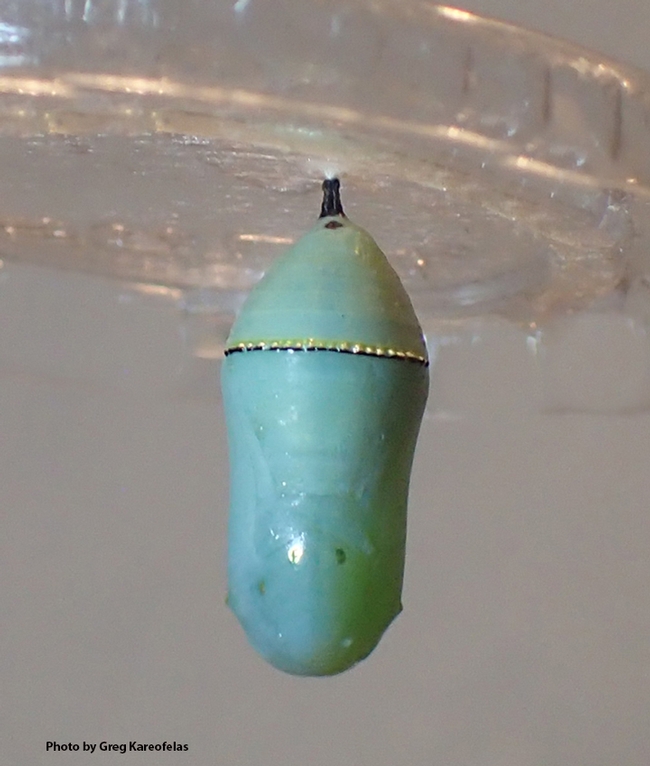
The Chrysalis: The caterpillar formed a chrysalis 12.5 days later. (Photo by Greg Kareofelas)
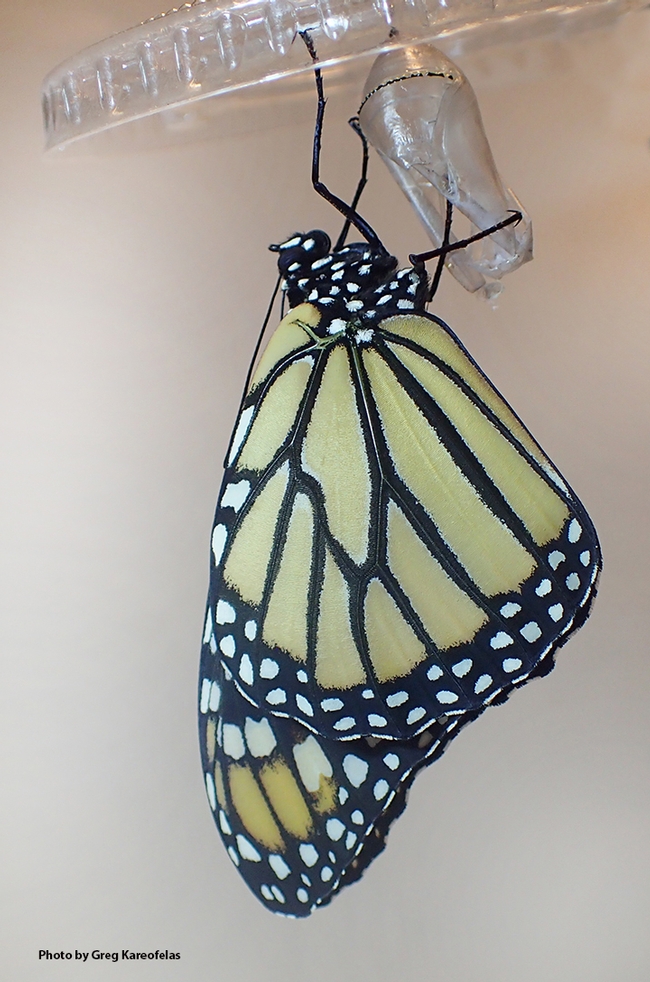
The Adult: The monarch eclosed only 8.5 days after forming the chrysalis and is shown here drying its wings. (Photo by Greg Kareofelas)
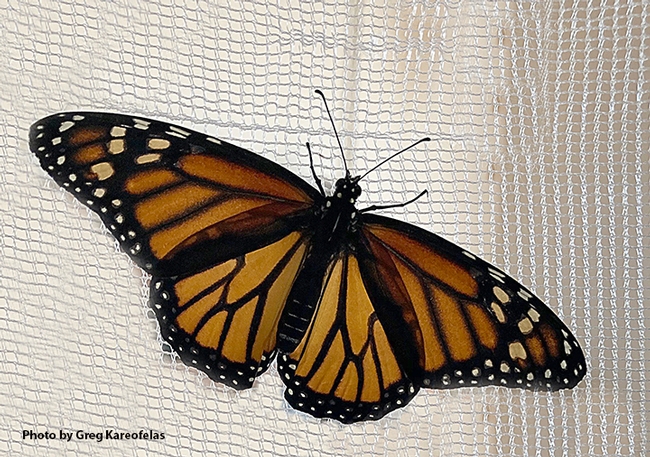
Meet Ruth: The monarch, a female, spreads her wings. Greg named her "Ruth," after Supreme Court Justice Ruth Bader Ginsburg, a champion of gender equality and women's rights. (Photo by Greg Kareofelas)